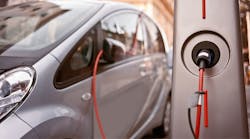Interoperability Could Spark Electric Car Wars
Ever have your iPhone battery die out and only find Android charging cords nearby? Wait until electric cars become more prevalent on the road. Each manufacturer has different standards for connectivity for charging. Tesla’s superchargers, for instance, are incompatible with other electric vehicles.
And that’s only one part of what may be an evolution-slowing shock for vehicles that are becoming ever-more digital: auto parts interoperability. Software systems today for cars may run on different platforms with potential consequences ranging from inefficient (locating replacement parts) to unsafe (if self-driving vehicles need to communicate with each other).
Not only will interoperability issues affect consumers, but also auto parts manufacturers, who may have to place expensive bets on competing technologies.
Of course, part of any leading company’s marching plans includes inventing a dominant technology – one that uses its proprietary systems and unique parts to corner a market. This is what made Microsoft dominant in PCs and enterprise software, and what made IBM’s OS obsolete.
Technology wars have existed for eons. If you’re a baby boomer or older, you'll recall standards wars such as VHS vs. Betamax. Back the wrong horse in that race, and you can lose big. Even earlier, radio, television and video recordings had technology compatibility issues. And little more than a century ago, Thomas Edison and Nikola Tesla fought a legendary battle over electricity standards.
Today, the auto industry is going through, arguably, its greatest era of innovation ever in decades. The race to build and market self-driving vehicles as well as so-called connected cars – with operating systems that resemble smart phones, with apps for everything from entertainment to digital diagnostics – has lured technology giants such as Google and Apple, as well as Elon Musk’s Tesla into the automotive business.
This means a time of both promise and peril for auto parts manufacturers. With reports that Apple’s so-called Project Titan aims to have a car on the road by 2019 and test drives of Google’s driverless car already in the news, makers of vehicle parts or systems will face a decision to commit to one project or another – or face the risk of sitting on the sidelines.
It’s important to remember that, in one sense, the question of interoperability is as old as the automobile itself, even if it wasn’t always described in those terms. At the dawn of the 20th century, for example, the Stanley Steamer was a popular vehicle that competed with the internal combustion engine made by Henry Ford and others. Running on steam – drivers sometimes stopped to fill up their boiler from the roadside troughs used by horses – it was a cheap way for Sunday drivers to navigate short distances.
But improvements in gasoline-powered cars – especially the electric starter, a major improvement on the difficult crank needed to get the Stanley Steamer going – made a once-innovative car obsolete. Today, a handful of antique collectors, starved for replacement parts, struggle to keep their century-old models on the road.
Since then, later technologies like the Wankel rotary engine popularized by Mazda in the 1970s faded due to problems with fuel economy, emissions and other issues. Every major change – such as the replacement of leaded gasoline with unleaded fuels – has created headaches for vehicle owners and for parts suppliers. (I’ll save discussing diesel engines for a day when Volkswagen is not in the news).
But the computer age, with smart chips and wireless communications, has raised the stakes for interoperability in cars. A decade ago, The National Institute of Standards and Technology (NIST) estimated that the automotive industry wasted $5 billion annually due to the lack of interoperability. And for years, the automotive industry actually has established an organization, the Automotive Industry Action Group (AIAG) to focus on standards between OEMs and suppliers.
Google has already announced partnerships with firms such as Continental AG, Robert Bosch, ZF and LG Electronics for its self-driving car. Rumors have it that they are in discussions with Ford as well. Apple, on the other hand, is known for its secrecy and exercising extreme control over both the hardware and software inside its technological innovations.
There are many possible ramifications in this technology battle. With software becoming more critical, traditional Tier 1 parts suppliers could find themselves pushed down to Tier 2 or Tier 3 in the next generation of cars.
But one thing seems clear: Most parts suppliers would be better served jumping on new vehicle programs early and quickly. In this high-tech car environment, it’s better to be a first mover than a fast follower, and nothing is worse than being a slow follower and getting shut out.
Daron Gifford is the partner leading automotive industry consulting at accounting firm and consultancy Plante Moran in Detroit.




